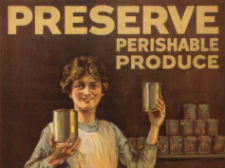Resources
Real baking challenges from the past!
On 04, Nov 2016 | In Resources | By Nicola Gauld
The commemoration of the First World War has seen a plethora of activity from media, museums, and community groups, much of it supported by the Heritage Lottery Fund.
The Home Front and the lives of women and families, once ‘hidden from history’, have received unprecedented attention. Academic historians have greeted this with both excitement and anxiety. We need to ask difficult questions about the politics of commemoration. How critically engaged is it? Is the Home Front is being used to make the horrors of war more palatable, or to illuminate the destruction and disruption to ordinary lives that lies behind the names on war memorials?
Like many people, I’ve spent the past ten weeks watching the Great British Bake off where amateur home-bakers are set a range of increasingly difficult challenges. I often wonder though, when the cloth is whipped off a pile of diverse ingredients surrounded by modern equipment, how well the bakers would have done faced with the baking challenges of wartime.
First World War rationing
At the start of the First World War, Britain was dependent on imports of food and by 1917 a German U-boat blockade had brought the nation to the brink of starvation.
Rationing was introduced along with a campaign to encourage the nation to eat less bread and use home grown ingredients in their baking.
This was one of the key factors in the popularity of the newly launched Women’s Institute whose cake baking demonstrations used vinegar instead of baking powder as a raising agent and jam preserved with salt rather than sugar.
The rise of the Women’s Institute
During the First World War Centenary the Pershore branch of the Women’s Institute has been exploring how the history of the WI was not all Jam and Jerusalem. They have been discovering how these pro-active women were instrumental in the success of the war.
From dishing up for Belgian refugees in communal kitchens to knitting socks for front line troops, the WI helped keep the home fires burning and ensured the nation was fed.
The research of the Pershore WI has inspired a further project, led by the Voices of War and Peace Engagement Centre, to explore how these WI First World War committees morphed into political movements after the war, once women received the vote.
Today’s Pershore WI was not alone in wishing to uncover this fascinating home front story. It joined forces with nearby HLF funded Pershore History Group and the University of Worcester to write a book “How the Pershore Plum won the Great War.”
I was fascinated to learn how schoolchildren, prisoners of war, Belgian refugees and Boy Scouts all played a part in the war effort by picking plums, looking after chickens and digging potatoes.
The group are still running talk and taste sessions and I have to say the potato shortbread sounds worth a try. You can read more about the project on our website.
Memories, and bakes, that survived 100 years
It is rare to be able to touch a piece of baking heritage so perhaps my favourite First World War item is the 100 year old Chelsea bun featured in the Leominster museum Rifles and Spades project.
Sent un-baked to frontline solider Alex Hodges by his sister Lily Poston just before the battle of the Somme, it was passed from hospital to hospital but never managed to catch up with its intended recipient. Returned to sender, it survived 100 years and was discovered by Private Hodges’ descendants. You can now see it on display at Leominster museum.
I think the longest Great British Bake Off creations have lasted was the memorable profiterole towers, and I seem to remember at least half of them fell over before the judges tasted them. Admittedly, despite the Leominster bun’s perfect condition I’m not sure it would be particularly tasty now.
Baking during the Second World War
The food and baking shortages of the Second World War are even more famous. B-Art’s Bread in Common, a Newcastle under Lyme based art group and real-bread bakery, interviewed local people about their baking traditions to create an online database.
A shortage of flour in the Second World War meant they discovered recipes for bread made out of peas, not a recipe I think I will try.
Encouraging people to get involved
Perhaps the best thing about these wartime recipes is that they give us a true flavour of what life was really like for those left behind. In our collective memory the hardships they suffered and efforts they made are often overshadowed by the story of troops in the trenches. But these women’s stories are equally a part of our history.
I hope these recipes and stories inspire more people to delve into the past and ensure everyone’s story is told and remembered.
The Heritage Lottery Fund’s First World War: Then and Now is helping. Grants of between £3,000 and £10,000 are available until 2019 for groups to explore and share the less well known stories of the First World War. But if you are keen to run a project exploring other aspects of our baking heritage you can apply for a grant through our open programmes.
Of course, these recipes can also still be useful today. They allow bakers with even the most limited ability like me, to be able to confidently follow the recipe and bring in to work something they made themselves.
If it turns out to be awful, overworked or with a soggy bottom, well then, isn’t that just an example of the trials and sacrifices people had to face in wartime.
Now, anyone for cake?
Elise Turner
Development Officer
HLF West Midlands



